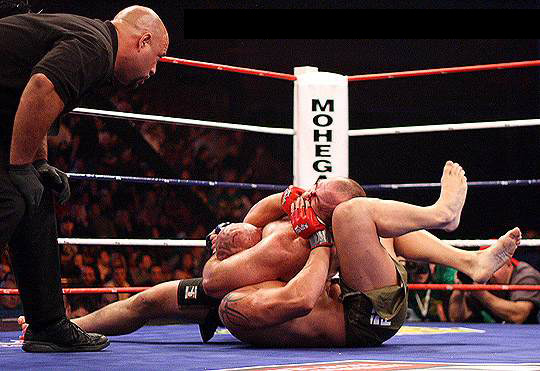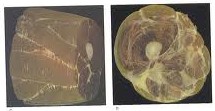Part 2 – Deep Tissue/Myofacial Techniques
Why is it that best plastic wrap seems to have a mind of it’s own? We’ve all done it: pulled the plastic wrap off the spool, severed it using the piranha toothed box blade, only to have the cellophane sheet instantly recoil into a wad more difficult to unravel than two MMA fighters grappling for the win in a title fight. We pick and pull at it, attempting to make it flat again but eventually, the plastic wrap forces us to tap out & chuck the whole ball in the trash.
No matter who you are, from the couch potato to the athlete, we all have a matrix this tenacious running throughout our bodies and it’s just as sticky and tricky, if not more so, than the most intelligent of MMA saran wrap. Every vessel, nerve, bone, organ, muscle is wrapped in our body’s version of plastic wrap. This extremely strong matrix of tissue helps either to hold all of these structures in place or provides support so they can slide or glide over each other without excessive friction. Think of it as soft webbing that acts as scaffolding for our inner structures helping them maintain shape and/or position inside your body. This web-like matrix is called “fascia.”
In a healthy system, fascia is normally flexible and elastic in nature. Of course add the challenge of every day living to that and this internal matrix can quickly become just as sticky, hard, and restrictive as our balled up plastic wrap! Injury, surgery, trauma (physical & emotional), repetitive movement, and poor posture can all take a toll on the health of the fascia.
To remind you about the question that sparked this blog series:
“Just got a massage and my tight muscles were really talking to me. Planning to do that more often so they detox regularly and can get the optimal growth I desire. Do you get massages regularly and how has it helped your physique?”
The way fascia impacts our range of motion and physical appearance is what immediately came to mind when I read this question (except the first blog in this series was already written so I published that one first).
When we get a massage, most people think our muscles are the only structures that require attention. Unhealthy fascia, however, can distort the look, symmetry, and function of a body. That’s because fascia isn’t just present in the body, it is highly sensitive and reactive especially in stressful situations. Challenging the body physically can cause this matrix to become thicker and even scarred. Even under emotional stress, fascia will become thicker as it perceives a threat – real or imagined!
In physical challenges, such as surgery or injury, the fascia can be severed. Be it by scalpel or stress induced tissue breakage, a scar forms within the fascia creating restriction akin to a snag in a sweater. If you’ve ever pulled the string in a sweater, you can get an idea as to how this impacts the body. Right now, grab a wad of the fabric of your shirt. Go ahead. Grab it and twist it tight. Oh don’t worry. No one is watching you (and if they are, just share this article and they won’t think you’re crazy – I got you covered). You can feel the tension of the fabric where you’re grabbing your shirt it but you also can feel the line of tension it creates as the fabric is strained on other parts of your torso. This is what it’s like getting a scar. The fascia thickens in the area of the scar but that’s not the end of it. Not only do you lose mobility around that scar, it creates a three dimensional strain through your entire body much like the shirt pull demonstrates!
Poor postural patterns and overuse syndromes can also cause fascia to thicken fixing our bodies into the very position we constantly repeat. Do you sit all day? Drive a car for hours on end? Are you stuck in a particular position all day? Wear the same restrictive uniform? Do you use your body the same way over and over again (computer operation, factory line work, dental hygienist, photographer, etc.)? If so, the fascia will adapt to support these very patterns you let yourself traverse day after day – like walking the same trail every day, you’re going to wear a grove in the ground on that path. Where the fascia is concerned, it will, over time, thicken to support the pattern you repeat or even protect you from heavy clothing or gear. Ever seen someone’s postural distortion, find out what they do for a living? Suddenly, the way that person walks or stands makes sense! You can tell which hip Mom carries her baby on even when she’s not holding the infant. Maybe you can see the pattern in your body from how you sit on the couch every night. And no offense to our law enforcement friends but I can pick out just about any cop off duty in a crowd by the way they walk and stand. It’s amazing how 25+ pounds of gun belt can create a profound pattern of thickened tissue around the waist that will make them walk like they’re still wearing it even when they’re out of uniform. As a result of these situations and more, our fascia can become much like ill-fitting clothing – the classic fascial wedgie, as it were.
the same restrictive uniform? Do you use your body the same way over and over again (computer operation, factory line work, dental hygienist, photographer, etc.)? If so, the fascia will adapt to support these very patterns you let yourself traverse day after day – like walking the same trail every day, you’re going to wear a grove in the ground on that path. Where the fascia is concerned, it will, over time, thicken to support the pattern you repeat or even protect you from heavy clothing or gear. Ever seen someone’s postural distortion, find out what they do for a living? Suddenly, the way that person walks or stands makes sense! You can tell which hip Mom carries her baby on even when she’s not holding the infant. Maybe you can see the pattern in your body from how you sit on the couch every night. And no offense to our law enforcement friends but I can pick out just about any cop off duty in a crowd by the way they walk and stand. It’s amazing how 25+ pounds of gun belt can create a profound pattern of thickened tissue around the waist that will make them walk like they’re still wearing it even when they’re out of uniform. As a result of these situations and more, our fascia can become much like ill-fitting clothing – the classic fascial wedgie, as it were.
Emotionally draining events ever leave you feeling really stiff and sore? This is partly your fascia working to protect you from the stress – good or bad. Because fascia surrounds everything in the body, even emotional strain can trigger your fascia to thicken around internal organs, vessels, and muscles in an effort to guard and preserve these structures vital for survival. This is what is called “body armoring” and we’ve all done it. During this emotional wear and tear, the fascial tissue implements intense guarding around structures. This may cause the entire body to feel too restricted to move – as if we bought clothing one size too small. It may even thicken around a certain organ it perceives needs more protection in the situation – lungs so we can breathe, heart for vital circulation. If it targets one area in particular, we can again have a similar “snag in the sweater” scenario simply from the tissue losing pliability. No incision required.
In any of these scenarios, bound up fascia can make us look and feel distorted – one shoulder raised, hips and torso torqued in opposite directions, arms hanging uneven distance from you side, and even your legs and feet rotating in odd directions. That’s because over time, as this thickened state persists, fascia becomes dehydrated, sticky, and shortened. In the case of a bodybuilder where symmetry is a key component in winning or losing, a flexible, non-restrictive fascia is key. Even for those not competing, restoring a healthy fascia can assist freedom of movement as well as proper body function overall.
 As mentioned before, fascia covers EVERYTHING in the body. Keeping this matrix flexible and hydrated is key not only in movement but also in cellular function. If the body becomes scarred and dehydrated, nutrition carried through the tissues has a harder time reaching it’s destination if at all. Without good nutrition, structures face potential weakening and disease states. With a healthy, flexible and well-hydrated fascia, it’s much easier for the body to function in renewal processes required for living.
As mentioned before, fascia covers EVERYTHING in the body. Keeping this matrix flexible and hydrated is key not only in movement but also in cellular function. If the body becomes scarred and dehydrated, nutrition carried through the tissues has a harder time reaching it’s destination if at all. Without good nutrition, structures face potential weakening and disease states. With a healthy, flexible and well-hydrated fascia, it’s much easier for the body to function in renewal processes required for living.
Myofascial approaches I practice work to restore pliability to these tissues so the body can operate more efficiently. Slow, methodical tissue stretching with emphasis on the feel of the fascia slowly unravels this sticky mess. After myofacial work, the client often reports greater range of motion and feeling of being free and even lighter. I often encourage increased water consumption following a myofacial session, as the tissues are ready to receive additional hydration in order to flush previously static areas.
Myofascial techniques may have the potential of being a little uncomfortable. Sensations such as burning or tearing sensations are sometimes reported as scars and bound up tissue are addressed. In these cases during treatment, I tell the client any discomfort you may experience should ALWAYS be within your pain tolerances – look for the “good hurt” sensation that says “this needs to happen for change” – if it’s anything but that, tell the therapist to back off into your tolerance zone. I also describe the technique as “feels really good when I stop” because often time the pain associated with the restriction goes away after the adhesion is broken up. Other times, myofascial work can be quite pleasant as the experience of tissue long stuck together becomes free and flexible again. Restoring proper range of motion allows the body to move in more optimal patterns as distorted gaits and postures can be the cause of many discomforts we endure.
So the next time you pull that saran wrap off the spool and it decides to put up a fight, consider the possibility that it’s merely reminding you that it’s time to book your massage session. The less you feel like that ball of saran wrap looks, the less of a chance you’ll be tapping out of living life to the fullest!!
Next blog – Thai Massage!




0 Comments